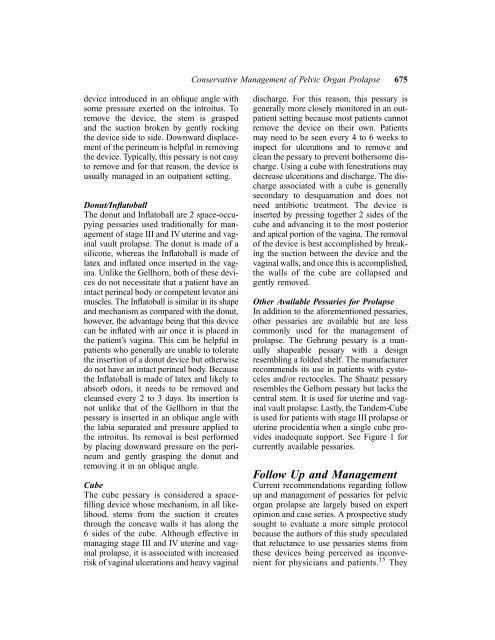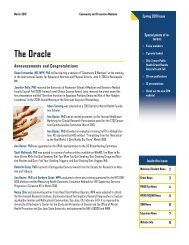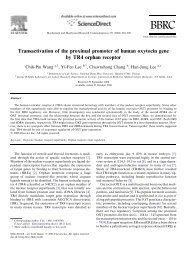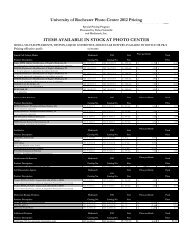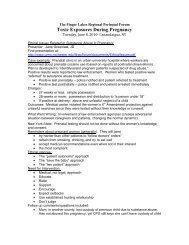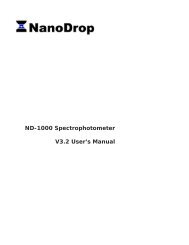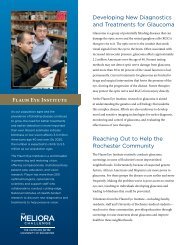Conservative Management of Pelvic Organ Prolapse
Conservative Management of Pelvic Organ Prolapse
Conservative Management of Pelvic Organ Prolapse
You also want an ePaper? Increase the reach of your titles
YUMPU automatically turns print PDFs into web optimized ePapers that Google loves.
device introduced in an oblique angle with<br />
some pressure exerted on the introitus. To<br />
remove the device, the stem is grasped<br />
and the suction broken by gently rocking<br />
the device side to side. Downward displacement<br />
<strong>of</strong> the perineum is helpful in removing<br />
the device. Typically, this pessary is not easy<br />
to remove and for that reason, the device is<br />
usually managed in an outpatient setting.<br />
Donut/Inflatoball<br />
The donut and Inflatoball are 2 space-occupying<br />
pessaries used traditionally for management<br />
<strong>of</strong> stage III and IV uterine and vaginal<br />
vault prolapse. The donut is made <strong>of</strong> a<br />
silicone, whereas the Inflatoball is made <strong>of</strong><br />
latex and inflated once inserted in the vagina.<br />
Unlike the Gellhorn, both <strong>of</strong> these devices<br />
do not necessitate that a patient have an<br />
intact perineal body or competent levator ani<br />
muscles. The Inflatoball is similar in its shape<br />
and mechanism as compared with the donut,<br />
however, the advantage being that this device<br />
can be inflated with air once it is placed in<br />
the patient’s vagina. This can be helpful in<br />
patients who generally are unable to tolerate<br />
the insertion <strong>of</strong> a donut device but otherwise<br />
do not have an intact perineal body. Because<br />
the Inflatoball is made <strong>of</strong> latex and likely to<br />
absorb odors, it needs to be removed and<br />
cleansed every 2 to 3 days. Its insertion is<br />
not unlike that <strong>of</strong> the Gellhorn in that the<br />
pessary is inserted in an oblique angle with<br />
the labia separated and pressure applied to<br />
the introitus. Its removal is best performed<br />
by placing downward pressure on the perineum<br />
and gently grasping the donut and<br />
removing it in an oblique angle.<br />
Cube<br />
The cube pessary is considered a spacefilling<br />
device whose mechanism, in all likelihood,<br />
stems from the suction it creates<br />
through the concave walls it has along the<br />
6 sides <strong>of</strong> the cube. Although effective in<br />
managing stage III and IV uterine and vaginal<br />
prolapse, it is associated with increased<br />
risk <strong>of</strong> vaginal ulcerations and heavy vaginal<br />
<strong>Conservative</strong> <strong>Management</strong> <strong>of</strong> <strong>Pelvic</strong> <strong>Organ</strong> <strong>Prolapse</strong> 675<br />
discharge. For this reason, this pessary is<br />
generally more closely monitored in an outpatient<br />
setting because most patients cannot<br />
remove the device on their own. Patients<br />
may need to be seen every 4 to 6 weeks to<br />
inspect for ulcerations and to remove and<br />
clean the pessary to prevent bothersome discharge.<br />
Using a cube with fenestrations may<br />
decrease ulcerations and discharge. The discharge<br />
associated with a cube is generally<br />
secondary to desquamation and does not<br />
need antibiotic treatment. The device is<br />
inserted by pressing together 2 sides <strong>of</strong> the<br />
cube and advancing it to the most posterior<br />
and apical portion <strong>of</strong> the vagina. The removal<br />
<strong>of</strong> the device is best accomplished by breaking<br />
the suction between the device and the<br />
vaginal walls, and once this is accomplished,<br />
the walls <strong>of</strong> the cube are collapsed and<br />
gently removed.<br />
Other Available Pessaries for <strong>Prolapse</strong><br />
In addition to the aforementioned pessaries,<br />
other pessaries are available but are less<br />
commonly used for the management <strong>of</strong><br />
prolapse. The Gehrung pessary is a manually<br />
shapeable pessary with a design<br />
resembling a folded shelf. The manufacturer<br />
recommends its use in patients with cystoceles<br />
and/or rectoceles. The Shaatz pessary<br />
resembles the Gelhorn pessary but lacks the<br />
central stem. It is used for uterine and vaginal<br />
vault prolapse. Lastly, the Tandem-Cube<br />
is used for patients with stage III prolapse or<br />
uterine procidentia when a single cube provides<br />
inadequate support. See Figure 1 for<br />
currently available pessaries.<br />
Follow Up and <strong>Management</strong><br />
Current recommendations regarding follow<br />
up and management <strong>of</strong> pessaries for pelvic<br />
organ prolapse are largely based on expert<br />
opinion and case series. A prospective study<br />
sought to evaluate a more simple protocol<br />
because the authors <strong>of</strong> this study speculated<br />
that reluctance to use pessaries stems from<br />
these devices being perceived as inconvenient<br />
for physicians and patients. 15 They


